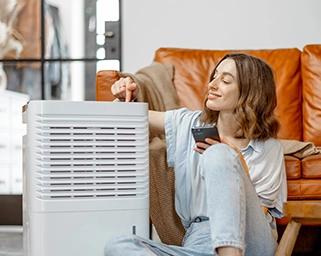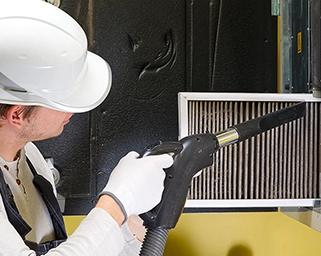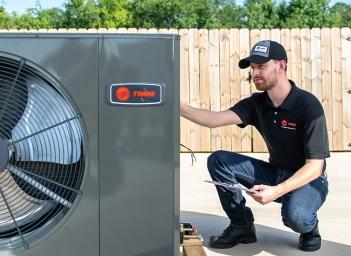How to Protect Your HVAC System from Mold Growth
The key to mold control is moisture control. Learn how to protect your HVAC system from mold growth, reduce health risks, and keep your house comfortable at the same time.
By Anne Fonda
You may or may not know this - mold spores are always present in the air. They’re smaller than the naked eye can see, but they’re always there. Mold becomes visible when spores land on a damp surface and begin to grow.
By controlling moisture in your HVAC system and controlling the humidity in your home, you can protect your home and your HVAC system from mold.
Understanding the causes of mold in HVAC systems
To understand how mold can get a foothold in your HVAC system, you need to understand some basics of how your air conditioner works.
Your central AC system’s indoor unit contains an important part called the evaporator coil. During the refrigeration cycle, the evaporator cools the air inside your home. The evaporator coil also extracts moisture from the air, reducing the indoor humidity.
When warm air blows across cold coils, condensation forms. When everything is working right, those water droplets of condensation drip down into a drain pan. It then flows down from the drain pan and exits your home through the condensate drain line.
Now let’s look at some common causes of mold in your HVAC system and your home.
Clogged drain pan/condensate drain line
A buildup of dust and grime can clog the drain line, causing moisture to drain slowly or not at all. This creates a damp environment and a home for mold growth, If it’s warm enough and damp enough, mold can start growing in your drain pan, in the condensate line, and even spread to other parts of your indoor unit, such as the blower fan.
Leaky air ducts
Ductwork mold can also take hold if you have leaky ducts. Leaks can allow mold spores inside, along with dust, heat, and moisture. That’s all mold needs to grow.
Damp and dirty air filters
Your HVAC air filters can trap mold spores and keep them from being blown into the air as it circulates throughout your home. You should change your filters every 30-90 days, depending on the filter type and quality. For a mini-split system, you can clean the filter, let it dry, and replace it. Our filter maintenance guide has further information.
If the air filter is clogged with dust and pet hair, it can start to retain moisture - which can allow mold to grow on the filter. That mold can then enter the HVAC system.
Improperly-sized AC unit
Another potential cause of mold in your home, and by extension, your HVAC system is the AC unit itself. Improper AC sizing means that an overly-sized unit can cool your home quickly but fail to reduce the humidity properly. Talk with your HVAC professional about whether your AC unit is properly sized for your home.
Signs of mold growth in HVAC systems
Signs of HVAC mold include:
- A musty odor coming from the air vents
- Visible mold growth on register vents, return vents, or ductwork
- Increased allergy symptoms
If you notice the first two signs, call in an HVAC professional. Depending on where you live and who you call, you may also need to call a mold remediation company. Increased allergy symptoms can be caused by a dirty filter or a high pollen count. Do some investigating to find the source of the allergy problems.
How do I prevent mold in my HVAC system?
There are 3 main things you can do to try and prevent mold in your HVAC system. They include:
#1: Control the humidity
Mold can begin to thrive when the humidity level in your home is at 60% or higher. This is why it’s important to run your air conditioner in the warmer months when humidity levels are naturally higher. Use bathroom fans or open a window to help remove humidity from bathrooms. You may also want to use a dehumidifier.
According to the Environmental Protection Agency (EPA), the ideal indoor humidity for comfort and mold prevention is between 30-50%. Lower humidity levels can also reduce the risk of dust mites and cockroaches. Consider installing a whole-house dehumidifier if you live in a particularly humid area such as Miami or Houston.
#2: Make HVAC system maintenance a priority
Change the HVAC air filters regularly. In addition, schedule an AC tuneup each year. An HVAC technician might be the first to spot a mold problem around your HVAC unit. They’ll clean the evaporator coil, check the drain pan and condensate line, and more. If they notice high humidity levels in your home, they may discuss some solutions.
#3: Seal leaky ducts
If you have leaky air ducts, they need to be sealed or replaced if they are too damaged. Your HVAC professional can perform airflow tests and use a remote camera to identify problem areas.
#4: Consider UV lights
HVAC UV lights are an add-on feature to help improve indoor air quality (IAQ) and prevent mold growth on your air conditioner or heat pump system’s evaporator coil.
They use UVC ultraviolet light to kill microorganisms by penetrating their cellular walls and destroying both nucleic acid and DNA, which effectively deactivates bacteria, viruses, and mold.
UVC rays are also not safe for human exposure. Since HVAC UV lights are UVC lights, technicians must take special precautions to turn off the light before servicing the unit.
What to do if you have mold in your HVAC ducts
Now you know how to prevent mold in your HVAC system. But what do you do if it's already there?
If you suspect mold in your AC system, you can call your local HVAC professional to evaluate the issue. Some HVAC companies provide air duct cleaning and can help decontaminate your HVAC system. Others may recommend that you contact a local mold remediation company.
For the EPA the jury is still out on the need for regular duct cleaning. However, the presence of large amounts of dust or clogs in the ductwork, or the presence of mold in the HVAC system are all scenarios that warrant air duct cleaning.
If you hire someone to perform air duct cleaning, make sure that they are a member of the National Air Duct Cleaners Association (NADCA). This helps ensure that your ducts are cleaned properly and up to industry standards. NADCA members don’t just clean the ductwork. They’ll inspect and clean the entire system, including
- air ducts
- coils
- drains
- drain pans
- registers
- grilles
- air plenum
- blower motor and assembly
- heat exchanger
- air filter
- air cleaner
They may also apply sanitizers, disinfectants, and other antimicrobial chemicals after mechanical surface cleaning to help address and prevent microbial contamination.
It’s important to note that until the root cause of the moisture and high humidity is addressed, the mold will return.
Work with HVAC professionals
High humidity is the root cause of mold in your HVAC ducts, or anywhere else in your home. Improper AC sizing, leaky ducts, and humid climates can all play a role. Contact your local Trane Comfort Specialist for an evaluation of your HVAC system to see if a whole-home dehumidifier or an upgrade to your air conditioning unit is in order.
Anne Fonda
Content Writer, Trane Technologies
A Content Writer with Trane Technologies, Anne Fonda researches topics and writes for Trane® and associated residential HVAC brands. She works in collaboration with Trane Technologies subject matter experts, offering easy-to-understand, informative content on complex topics. Her goal is to help consumers make informed decisions on the products and services they need.
She has written for HVAC and other service provider websites for over 16 years. Before transitioning to web content writing, Anne had a 14-year stint as an award-winning journalist. She graduated cum laude from the University of Missouri-Columbia School of Journalism.
When she’s not working, Anne enjoys playing word games, reading, gardening, spending time with family, and visiting gardens and museums.
Mark Woodruff, Senior Product Manager, Ducted Outdoor




